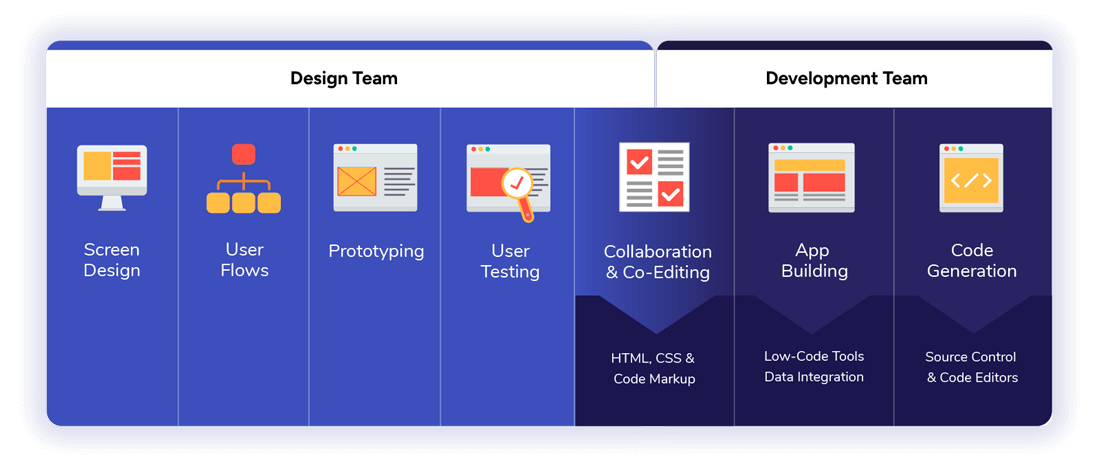

How Can CTOs Achieve Faster Time to Market with Low Code?
By embracing low code and democratizing app development, companies can fundamentally transform the way their businesses operate, enabling faster, more agile product development and achieving shorter time to market. But why is this important?
Over the last few years, companies have been reassessing their processes and business strategies, navigating between accelerated digital transformation, optimizing resources, and delivering solutions more efficiently to achieve faster time to market. However, several challenges remain: resource constraints, increasing development costs, generating margin revenue, increasing ROI, complex app building processes requiring different skills and know-how in frameworks, and rapid shifts in consumers’ demands.
Luckily, executives are starting to recognize the critical role of advanced and novel technology, like App Builder, in helping their organizations adapt and grow during challenging times for the industry.
Embracing low code and democratizing app development, then, is how they can fundamentally transform the way their businesses operate, enabling faster, more agile product development.
Why is Accelerating Time to Market Crucial for Businesses?
Speed is essential nowadays for companies to achieve their goals, capture market share, and capitalize on customer demands. That’s why focusing business strategies on achieving shorter time to market is critical. In fact, it becomes a turning point where opportunities begin and the business starts prospering, securing its competitive relevance in an already crowded market.
The faster a company can move projects along with automation tools, the more it can lower development costs and bottlenecks. Developer teams tasked with innovating within existing systems or architectures may face challenges associated with legacy code, technical debt, and outdated technology stacks. These obstacles slow down the development cycles, affecting the time to market. However, when teams are given the right tools to facilitate any process from design to code, it will have the opposite effect – faster development.
What Affects Time to Market?
There are several key factors that affect time to market, including:
Product Type, Complexity, and Scope
Updating a consumer social app within an established and well-researched industry could ideally move from conceptualization to launch in months. Thus, according to 452 Research, “the overall benefit of a DAP (digital automation platform) is speed. In general, they can potentially shave 50-90% off development time vs. a coding language.
We believe low-code DAPs will craft nearly half of all applications developed in the coming years because they take less time to prototype, test, and deploy to production.” And when companies leverage the same tech stack across projects, a low-code tool for example, it can streamline the process significantly. Developers won’t have to switch from one platform to another. They will have all the tools in one place, benefiting from automation.
Resource Availability
Allocating developers with the right skill set is crucial because they can meet milestones and achieve maximum efficiency. While developer shortages can lead to delays and slow time to market. In an annual survey by Reveal, results indicate that more than a third of respondents (37.5%) said they struggled to find skilled developers in 2023, with DevOps Engineer, Data Analytics Developer, and IT Security Engineer being the hardest jobs to fill. Luckily, things have been changing for the better, thanks to low code, which solves the lack of skilled developers by democratizing code and enabling automation.
Innovative Edge
If you have a development team but lack the right tools, it can hinder the company’s ability to innovate and build solutions without compromising quality or speed. However, maximizing on low code and innovative tools like App Builder can accelerate the process. Teams can iterate on new ideas much faster, quickly prototype, deliver MVPs, and go from an idea to a completely developed and deployed product within a significantly shorter timeline.
Regulatory Requirements
Some sectors, like healthcare or finance, require more rigorous testing to comply with regulatory standards and obtain the necessary approvals. This can extend development times. And typically, low-code tools allow for building apps that adhere to legal and regulatory standards and comply with industry best practices.
How to Achieve Faster Time to Market With Low-Code Development
Platforms like App Builder can significantly enhance the speed and efficiency of the development process. That’s why it serves as a solution that enables organizations to achieve faster time to market through several key advantages.
Speed in Application Development
Everyone wants speed and quality when developing solutions and low code ensures that. With traditional coding, developing apps and achieving business agility can be time-consuming. On the other hand, with low-code platforms, business and development processes are accelerated, reducing the need for design teems or the amount of hand-coding needed. Tools like App Builder offer intuitive, drag-and-drop visual development interfaces that enable users to quickly design applications and user interfaces without writing extensive code.

This visual approach accelerates iteration cycles and allows users to experiment rapidly with different design patterns and configurations. You save your company and team time and effort, enabling the business to adapt and scale with greater agility.
Flexibility and Faster Iterations
Hand coding requires developers to write code line by line, which can be time-consuming and repetitive, particularly for routine code. This tedious and manual effort reduces developer productivity and impedes the rapid iteration and delivery of software solutions, especially in fast-paced development environments. But App Builder allows your teams to benefit from rapid prototyping, testing, code generation for popular web frameworks, code preview, and deployment of applications while facilitating your team’s flexibility to easily respond to changing market needs.
Empowering Citizen Developers
Low-code platforms democratize code and empower developers with different skill levels (even citizen developers) to quickly build and deploy apps without extensive manual coding. This drastically reduces the time it takes to go from an idea to a full-scale launch.
Minimizing Technical Debt
Scaling applications without low-code tools can lead to the accumulation of technical debt, such as poorly structured code, outdated dependencies, and undocumented workarounds. Technical debt hampers long-term scalability, maintainability, and extensibility, as developers must dedicate time and effort to address accumulated debt and prevent future issues.
Ensuring Scalability and Performance
Low-code platforms are built on scalable architectures that can accommodate the growth of applications over time. These architectures typically leverage cloud infrastructure and microservices-based designs to enable horizontal and vertical scaling, ensuring that applications can handle increased user loads, data volumes, and transaction rates.
Best Practices for Implementing Low Code
So, how can you accelerate time to market? Although there is no secret formula for faster time to market, a few best practices and proven tactics can facilitate the process. Here’s a checklist for CTOs to accelerate time to market.
- Establish a Go-To-Market (GTM) Strategy
There may be certain challenges when implementing new technology to develop and introduce products or services on the market. That’s why having a successful go-to-market (GTM) strategy in the first place is crucial. It will help prioritize resource allocation, budget, business goals, etc. And it will also allow you to more clearly and specifically identify different areas in the business where low code can be integrated to be most effective.
- Choosing the Right Platform Based on Your Business Needs
Research by Forrester indicates that “Low-code development platforms are emerging as a key strategy to accelerate app delivery to support digital business transformation. And they can potentially make software development as much as ten times faster than traditional methods.” However, CTOs and other executives must consider questions such as: Are there any limitations within the tools? Is the tool able to improve your project margins? Does it allow you to adapt to customer needs and keep pace with innovations quickly? What about security and compliance features?
- Assessing Available Technical Resources
Evaluating existing skills and tools allows CTOs to determine how to best utilize their resources. For this purpose, you must consider how well the low-code tool you want to use integrates within the current teams and processes. Ask the following questions: What is the current workload of the development team? What technical skills do programmers currently have? How familiar are they with low-code development platforms? Does the platform offer training resources?
- Ability to Create Product Value Streams
Can you deliver product value streams with the tool of your choice? In essence, with the right low-code tool, you will be able to provide the highest possible value to customers by maximizing efficiency and minimizing waste throughout the entire design-development cycle. This results in eliminating silos and fostering a more productive environment where teams are dedicated to specific product outcomes. Nothing gets hindered by misaligned objectives or dysfunctional product vision across fusion teams.
- Consider Your Budget, Objectives and Key Results, and Cost of Delays
Platforms can vary significantly in pricing. Understanding your budget, then, helps ensure that the chosen low-code platform fits within your financial constraints. Platforms can vary significantly in pricing. Understanding your budget, then, helps ensure that the chosen low-code platform fits within your financial constraints.
When it comes to OKRs, consider these factors, too, to see whether the low-code tool will align with your business strategy. Lastly, understanding the financial implications of slow development cycles is also something to think about. Make sure the platform has the features and capabilities to eliminate delays.
Wrap-Up and Key Article Takeaways
C-level executives must act fast to ensure their businesses and teams stay ahead of the competition while driving new revenue streams in a market that shifts dynamically. Today, it is more imperative than ever to accelerate innovation and ensure a shorter time to market. Especially when businesses keep pace with emerging technologies and growing demands from tech-savvy customers.
But how to achieve that?
- Speed up app development using innovative tools like App Builder and low code.
- Assess your available technical resources, determine your business goals, and align these two.
- Establish a Go-To-Market strategy, prioritizing teams’ allocation. Consider critical areas that can be optimized, such as your budget and team resources.
- Evaluate the technical dept and invest in modernizing outdated systems to avoid risks in the long run.


